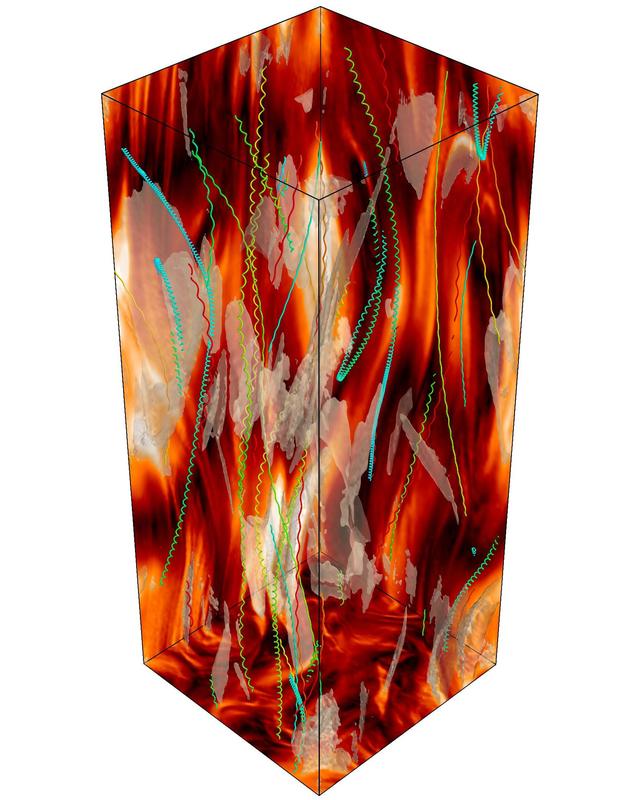IPP launches new centre for plasma astrophysics

Supercomputer simulation of the movement of energy-rich particles in astrophysical plasma turbulence. (Graphic: Daniel Grošelj, IPP)
The Helmholtz Excellence Network “Munich Center for Plasma Astrophysics” headed by Professor Frank Jenko from the Max Planck Institute for Plasma Physics (IPP) in Garching near Munich will commence its work on 1 May.
The Center is being funded with around a million euros by the Helmholtz Association of German Research Centres. The main objective will be to contribute to the excellence cluster ORIGINS through studies relating to plasma astrophysics.
Understanding the evolution of the universe all the way from the Big Bang to the emergence of life – this is one of the biggest challenges in science. To this topic the excellence cluster ORIGINS devotes itself, one of the successful candidates in what is now the third round of funding from the “excellence initiative” launched by the federal administration and federal states to promote research.
In addition to Munich’s two universities, ORIGINS also counts the Max Planck Institutes for Astrophysics, Biochemistry, Extraterrestrial Physics, Physics and Plasma Physics, as well as further institutions in Munich and Garching among its participants.
The preliminary scientific work for IPP’s application for ORIGINS has already received over EUR 350,000 in support from the Helmholtz Association of German Research Centres, to which IPP is affiliated as an associated institute.
With the Helmholtz Excellence Network “Munich Center for Plasma Astrophysics”, this work will enter a new phase from May 2019: the Helmholtz Association is providing around a million euros in funding for establishing and maintaining of a group of IPP scientists, which will contribute to ORIGINS by building on the preliminary work carried out so far.
Black holes and cosmic accelerators – plasma is everywhere
“Of the issues addressed by ORIGINS, IPP is particularly interested in investigating turbulent flows and high-energy particles,” says IPP scientist Professor Frank Jenko, who leads the Helmholtz Excellence Network. Although gravity plays a central role in astrophysics, it is not the sole driver of dynamics and self-organization in the universe. A large part of the energy is found in magnetic fields or cosmic radiation, and the overwhelming proportion of visible space is made up of turbulent plasma.
Plasma turbulence is the key, for example, to understanding the glowing plasma disks around supermassive black holes – one of which was recently imaged for the first time in the star system M87. Plasmas are also behind the enormous speeds of cosmic ray particles with energies billions of times larger than achievable with the largest accelerators on earth.
“Topics such as this fall within the fascinating area of plasma astrophysics,” says Frank Jenko: “Similar processes also play an important role in IPP’s fusion experiments, as do self-organization processes far from thermodynamic equilibrium, which are omnipresent both in space and in laboratory plasmas.”
In order to predict its behaviour, the complex plasma system can be described using fundamental nonlinear equations, which can usually only be solved using elaborate computer simulations. As a world leader in this area, IPP will contribute its expertise to ORIGINS and turn it to practical use in close collaboration with the field of astrophysics.
Frank Jenko anticipates that this will help to build numerous bridges between fusion experiments and the world of astrophysical observation: “The underlying plasma physical processes satisfy the same equations, whether they take place in the lab or in nature”.
Background
IPP studies high-temperature plasmas in experiment and theory with a view to establishing the physical basis for a fusion power plant. Like the sun, a future power plant of this kind is intended to derive energy from the fusion of atomic nuclei. The fuel – a low-density, extremely hot hydrogen plasma – must be confined by magnetic fields so tightly that it floats in an almost contact-free manner within the interior of a vacuum chamber.
Media Contact
All latest news from the category: Physics and Astronomy
This area deals with the fundamental laws and building blocks of nature and how they interact, the properties and the behavior of matter, and research into space and time and their structures.
innovations-report provides in-depth reports and articles on subjects such as astrophysics, laser technologies, nuclear, quantum, particle and solid-state physics, nanotechnologies, planetary research and findings (Mars, Venus) and developments related to the Hubble Telescope.
Newest articles

Bringing bio-inspired robots to life
Nebraska researcher Eric Markvicka gets NSF CAREER Award to pursue manufacture of novel materials for soft robotics and stretchable electronics. Engineers are increasingly eager to develop robots that mimic the…

Bella moths use poison to attract mates
Scientists are closer to finding out how. Pyrrolizidine alkaloids are as bitter and toxic as they are hard to pronounce. They’re produced by several different types of plants and are…

AI tool creates ‘synthetic’ images of cells
…for enhanced microscopy analysis. Observing individual cells through microscopes can reveal a range of important cell biological phenomena that frequently play a role in human diseases, but the process of…





















